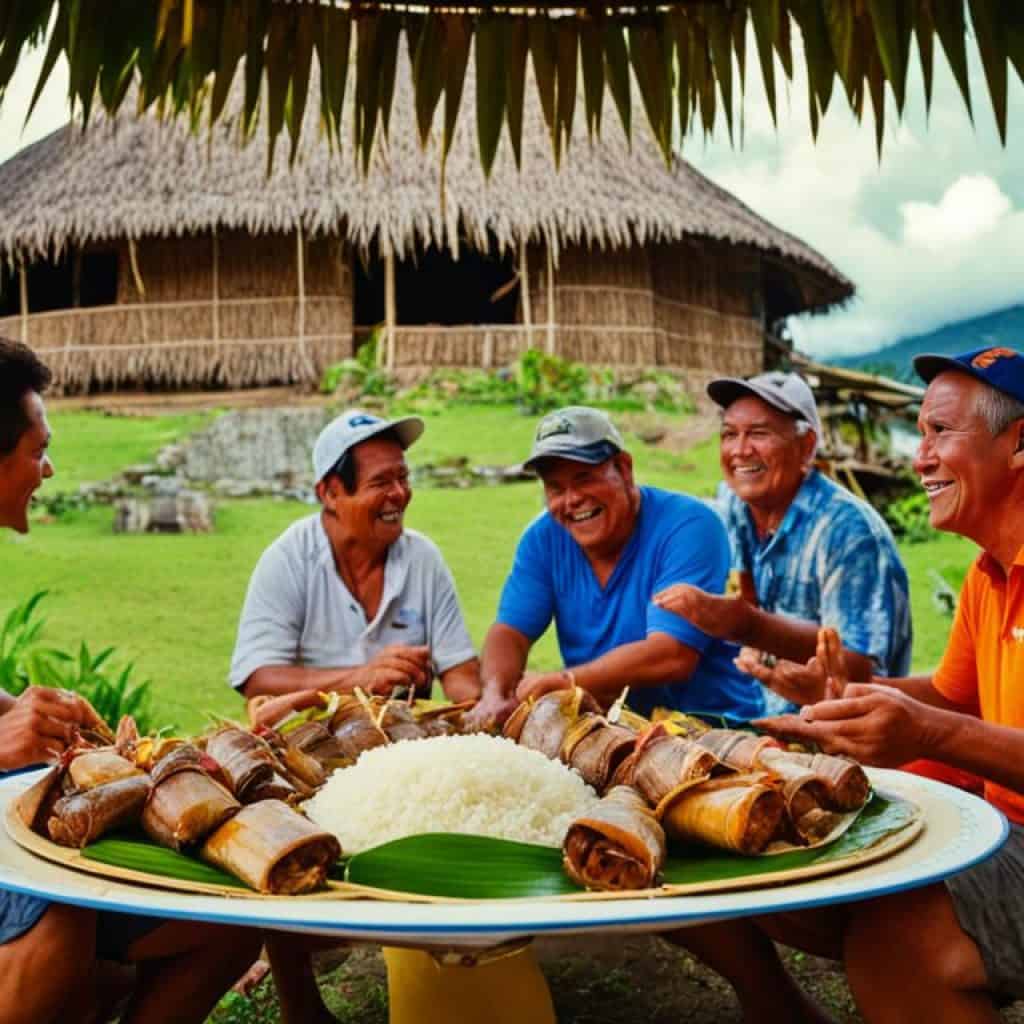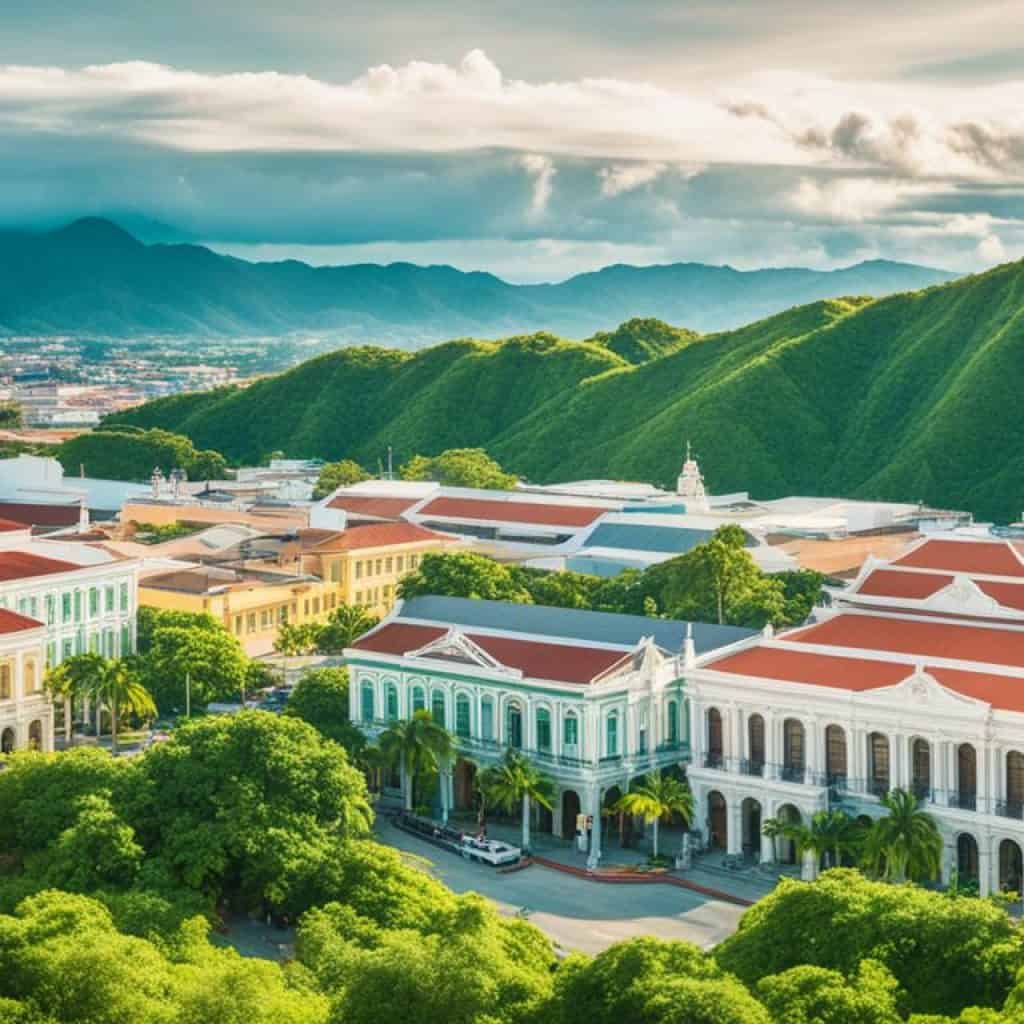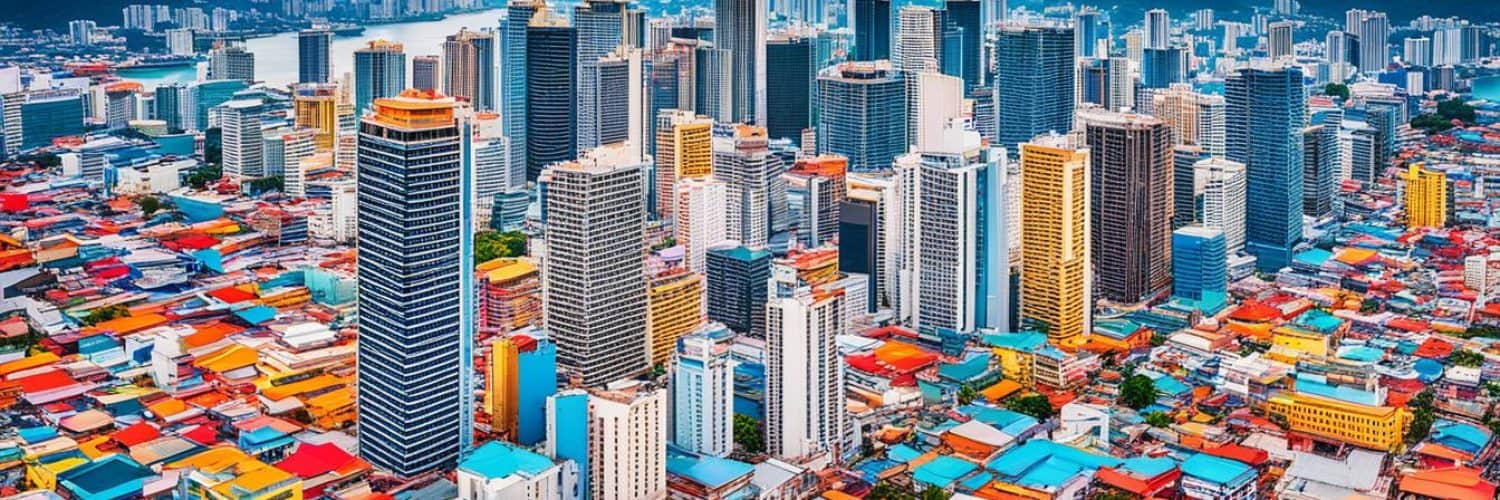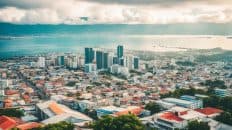Welcome to Cebu, the Queen City of the South! Have you ever wondered what makes this bustling metropolis in the Philippines truly special? Is it the urban hub that beckons adventurers? Or perhaps the historical charm that captivates history enthusiasts? You’re about to embark on a journey of discovery as we uncover the secrets and wonders of this vibrant capital of the Philippines.
Key Takeaways:
- Cebu is the oldest city in the Philippines and is known for its rich history, vibrant culture, and stunning natural attractions.
- Explore the best times to visit Cebu and experience the famous Sinulog Festival.
- Discover the unique language and culture of Cebu, deeply rooted in Catholicism.
- Indulge in the must-try Cebuano food and immerse yourself in the local culinary scene.
- Find the perfect accommodations in Cebu to suit your budget and preferences.
Best Times to Visit Cebu
Planning a trip to Cebu? You’ll want to make sure you choose the best time to visit this vibrant city. Cebu offers something for every traveler, whether you’re interested in exploring historical sites, indulging in delicious cuisine, or experiencing colorful festivals.
The best time to visit Cebu is between December and May, when the weather is dry and sunny. The city comes alive during this period, offering clear skies and warm temperatures, perfect for outdoor activities and beach adventures.
One of the highlights of visiting Cebu in January and February is the Sinulog Festival. This grand celebration, held every third Sunday of January, honors the city’s patron saint, Sto. Niño de Cebu. The festival features a vibrant parade, cultural performances, and street parties that showcase the rich heritage and traditions of Cebuano culture.
“The Sinulog Festival is a must-see event that truly captures the spirit and energy of Cebu. It is a unique celebration that combines religious devotion and cultural festivities, creating a memorable experience for both locals and tourists.”
If you’re on a budget, visiting during the rainy season, which lasts from June to November, can offer more affordable accommodations. However, keep in mind that the weather can be unpredictable during this time. There may be occasional rainfall and the possibility of tropical storms, so it’s essential to pack a raincoat or umbrella and plan your activities accordingly.
Whether you choose to visit during the sunny months or brave the occasional rain showers, Cebu will captivate you with its beauty, culture, and warm hospitality.
Experience the vibrant festivities of the Sinulog Festival or relax on the stunning beaches during the best time to visit Cebu. The choice is yours, and either way, you’re sure to create cherished memories in this enchanting destination.
Sinulog Festival – A Colorful Celebration
The Sinulog Festival is undoubtedly one of the most magnificent and highly anticipated festivals in the Philippines. Celebrated every third Sunday of January, this grand event pays homage to Sto. Niño de Cebu, the beloved patron saint of the city. The festival is a vibrant display of culture, tradition, and religious devotion, drawing both locals and tourists alike to the colorful streets of Cebu.
The highlight of the Sinulog Festival is the exhilarating grand parade, where thousands of participants, adorned in elaborate and vibrant costumes, dance to the rhythmic beat of drums and indigenous instruments. The streets come alive with energy and excitement as the parade winds its way through the city, showcasing the rich cultural heritage of Cebu.
“The Sinulog Festival is a testament to the deep-rooted faith and strong devotion of the Cebuanos to Sto. Niño de Cebu. It is more than just a celebration; it is a profound expression of gratitude and reverence.”
Throughout the festival, the streets are filled with activities and performances that showcase the diverse cultural traditions of Cebu. Visitors can witness magnificent displays of indigenous dances, including the traditional Sinulog dance, which embodies grace, precision, and storytelling. From street parties to cultural exhibitions, the Sinulog Festival offers a multitude of experiences that engage the senses and immerse attendees in the rich cultural tapestry of the region.
As night falls, the city becomes a vibrant sea of colors, with fireworks illuminating the sky and the echoes of music and laughter filling the air. The festivities extend into the evening, with various entertainment acts and performances taking center stage. It is a time of jubilation and unity, as people from all walks of life come together to celebrate and honor their shared heritage.
The Significance of Sto. Niño de Cebu
Sto. Niño de Cebu, also known as the Holy Child Jesus, holds immense significance in the hearts and minds of the Cebuanos. The icon of Sto. Niño de Cebu is believed to be the same image that was given to Queen Juana of Cebu by the Portuguese explorer Ferdinand Magellan in 1521. This symbolic representation of their faith has become a powerful symbol of protection, blessings, and miracles for the people of Cebu.
| Date | Event |
|---|---|
| Friday | Opening Salvo |
| Saturday | Fluvial Procession and Solemn Foot Procession |
| Sunday | Grand Parade and Street Performances |
| Monday | Reenactment of the Arrival of the Santo Niño in Cebu |
| Tuesday | Awarding Ceremonies |
As visitors immerse themselves in the colorful merriment of the Sinulog Festival, a sense of unity and camaraderie permeates the atmosphere. It is a celebration that transcends boundaries, connecting people through a shared appreciation for culture, tradition, and spirituality. The Sinulog Festival is undoubtedly an experience that should not be missed, offering a glimpse into the vibrant soul of the Queen City of the Philippines.
Getting Around Cebu
Exploring the vibrant city of Cebu is a breeze with a variety of transportation options available. From traditional jeepneys to convenient taxis and adventurous motorbikes, getting around Cebu is an adventure in itself.
Jeepneys – Affordable and Authentic
When it comes to transportation options in Cebu, jeepneys are the most affordable and authentic choice. These vibrant, multi-colored vehicles are a common sight on the streets of Cebu, and they provide a unique and immersive way to experience the city. Hop on a jeepney, mingle with the locals, and enjoy the bustling atmosphere as you navigate your way through the city’s neighborhoods.
Taxis – Comfort and Convenience
If you prefer a more comfortable and convenient ride, taxis are readily available in Cebu. With air-conditioned vehicles and professional drivers, taxis offer a hassle-free way to reach your destination. Whether you’re exploring downtown Cebu, heading to a shopping mall, or visiting tourist attractions, taxis provide a comfortable and reliable transportation option.
Motorcycles – Embrace the Adventure
For short distances or a taste of excitement, consider hopping on a motorcycle taxi, locally known as habal-habal. These nimble and efficient motorcycles can weave through traffic, allowing you to reach your destination quickly. Embrace the adventurous spirit and enjoy the thrill of riding on two wheels as you explore the city.
Motorbike Rental – Freedom and Flexibility
If you’re feeling even more adventurous and want the freedom to explore at your own pace, consider renting a motorbike. With a rented motorbike, you can take full control of your itinerary, visiting both popular attractions and hidden gems in and around Cebu. Just be sure to familiarize yourself with the local traffic rules and regulations before hitting the road.
Heavy Traffic – Plan Your Journeys
While Cebu offers various transportation options, it’s important to note that heavy traffic can be a challenge, especially during rush hours. Plan your journeys accordingly, allowing extra time for potential delays. Consider using public transportation or exploring on foot if you’re traveling short distances to avoid getting caught in congested roads.
Language and Culture of Cebu
Cebu, known as the Queen City of the South, is a vibrant and diverse city that is deeply rooted in its language and culture. With influences from Spain, China, and America, Cebu has become a melting pot of traditions and customs.
The official language of Cebu is Cebuano, a language widely spoken in the region. Alongside Cebuano, many locals also speak Tagalog and English, making it easier for visitors to communicate and connect with the friendly community.
The culture of Cebu is greatly influenced by its strong Catholic faith. As the birthplace of Christianity in the Philippines, Catholicism plays a significant role in the lives of Cebuanos.
The city is adorned with numerous churches and religious monuments, each holding historical and cultural importance. From the majestic Basilica Minore del Santo Niño to the iconic Santo Rosario Parish Church, these architectural wonders stand as witnesses to the deep-rooted Catholicism in Cebu.
Immerse yourself in the rich cultural heritage of Cebu by exploring these iconic landmarks and participating in religious festivals and processions that showcase the devotion and faith of the Cebuano people.
Churches in Cebu
| Church | Location | Features |
|---|---|---|
| Basilica Minore del Santo Niño | Fuente Osmeña, Cebu City | – Home to the oldest religious relic in the Philippines – Venue for the annual Sinulog Festival |
| Santo Rosario Parish Church | San Roque, Cebu City | – Known for its beautiful architecture – Holds regular processions and religious activities |
| Cebu Metropolitan Cathedral | Mabolo, Cebu City | – One of the oldest churches in Cebu – Features stunning stained glass windows |
| Archdiocesan Shrine of Our Lady of Guadalupe | Guadalupe, Cebu City | – Pilgrimage site for devotees of Our Lady of Guadalupe – Offers a panoramic view of Cebu City |
Experience the warmth and charm of Cebuano hospitality as you interact with the locals and discover the stories and traditions that make Cebu a truly special place.

Must-Try Cebuano Food
Food is an essential part of Cebuano culture, offering a delectable insight into the rich culinary traditions of the region. From mouth-watering roasted pig to delightful mangoes, Cebuano cuisine is a treat for the taste buds. Here are some must-try dishes that will take you on a gastronomic adventure through the flavors of Cebu.
Lechon – The Pride of Cebuano Cuisine
When it comes to Cebuano cuisine, one cannot miss the famous lechon. This roasted pig dish is known for its crispy skin and succulent meat. The whole pig is carefully seasoned and slow-roasted over an open fire, creating a heavenly combination of flavors and textures. Lechon is a staple in celebrations and special occasions, representing the pride and culinary heritage of Cebuanos.
Puso – A Unique Rice Dish
Another iconic dish of Cebu is puso, a rice delicacy with a unique presentation. Puso, which means “heart” in the local dialect, is rice cooked inside a coconut leaf pouch. The result is a perfectly steamed rice cake shaped like a heart. Puso is commonly enjoyed with grilled or roasted meats, providing a delicious accompaniment that adds a subtle coconut aroma to each bite.
Danggit – A Breakfast Delight
Cebu is also famous for its danggit, a dried fish that is a breakfast staple in the region. Danggit is typically marinated in a blend of spices and then sun-dried to achieve its distinct flavor. When fried to a crispy golden brown, danggit becomes a deliciously salty and savory treat that pairs perfectly with rice and eggs, giving you a true taste of Cebuano mornings.
Balut – An Exotic Culinary Adventure
For the adventurous foodies out there, Cebu offers the unique experience of trying balut. Balut is a fertilized duck egg that is boiled and eaten with the developing embryo inside. It may sound intimidating, but balut is considered a delicacy and is appreciated for its rich flavors and textures. Take a bite to savor the combination of yolk, partially formed duckling, and broth, and embrace the culinary adventure that Cebu has to offer.
Cebu Mangoes – A Tropical Sweetness
No visit to Cebu is complete without indulging in its succulent mangoes. Cebu is known for producing some of the best mangoes in the world. These golden delights are incredibly sweet, juicy, and bursting with tropical flavors. Whether you enjoy them fresh, as a refreshing smoothie, or in a luscious dessert, Cebu mangoes are a true tropical delight that will leave you craving for more.
Immerse yourself in the vibrant flavors of Cebuano cuisine and discover the culinary treasures that make this region a food lover’s paradise. From the mouth-watering lechon to the unique puso, danggit, balut, and irresistible mangoes, Cebuano cuisine offers a diverse and exciting gastronomic experience that will leave you wanting to come back for seconds.
Accommodations in Cebu
When planning your trip to Cebu, it’s essential to choose the right accommodations that suit your budget and preferences. Thankfully, Cebu offers a wide range of options, from budget-friendly hostels to luxurious resorts with breathtaking views.
Budget Options
If you’re looking for affordable accommodations in Cebu, there are plenty of budget-friendly options available. Hostels and guesthouses are popular choices among budget travelers, offering comfortable dormitory-style rooms and communal spaces to meet fellow adventurers. These budget options allow you to save on your accommodation expenses, leaving more room in your budget to explore the city’s attractions and indulge in delicious Cebuano cuisine.
Mid-Range Hotels
For travelers seeking a balance between comfort and affordability, mid-range hotels in Cebu are the perfect choice. These hotels offer well-appointed rooms, modern amenities, and convenient locations. You can expect friendly service and personalized attention without breaking the bank. Many of these mid-range hotels also provide various facilities like swimming pools, fitness centers, and on-site dining options to enhance your stay.
Luxury Hotels and Resorts
If you’re looking for a touch of luxury and indulgence during your stay in Cebu, there are several upscale hotels and resorts that will exceed your expectations. These luxurious accommodations offer world-class amenities, spacious rooms with stunning views, and impeccable service. Pamper yourself with spa treatments, unwind by the pool, and savor gourmet meals prepared by renowned chefs. These luxury hotels and resorts provide a haven of tranquility and sophistication, ensuring a memorable stay in Cebu.
Downtown Cebu vs. Mactan Island
When choosing accommodations in Cebu, it’s important to consider the location and proximity to the attractions you plan to visit. Downtown Cebu is the best choice if you want to explore historical sites and immerse yourself in the vibrant city center. You’ll have easy access to iconic landmarks, museums, shopping districts, and bustling city life.
On the other hand, if you’re dreaming of pristine beaches and relaxation, Mactan Island is the perfect destination. Home to luxurious beachfront resorts, Mactan Island offers a tropical paradise complete with crystal-clear waters, white sandy beaches, and a range of water sports activities. Whether you’re looking to unwind in a beachside cabana or snorkel among vibrant coral reefs, Mactan Island provides a tranquil escape from the hustle and bustle of downtown Cebu.
Whichever accommodations you choose in Cebu, you’re sure to find a comfortable and convenient base for your adventures. From budget options to luxurious hotels, downtown Cebu to Mactan Island, there’s something for every traveler’s taste and budget. Make the most of your stay in Cebu by selecting the perfect accommodations that enhance your experience in the Queen City of the Philippines.
Safety Tips in Cebu
Cebu is a generally safe place to visit, but it’s always important to take precautions and ensure your personal safety. Here are some essential safety tips to keep in mind during your stay:
1. Avoid walking alone at night
It’s wise to avoid walking alone at night, especially in dimly lit areas. Stick to well-lit and populated streets whenever possible. If you need to travel after dark, consider taking a taxi or using ride-sharing services for added safety.
2. Keep your belongings safe
Be mindful of your belongings and keep an eye on your bags and pockets, especially in crowded areas. Keep your valuables close to you and avoid displaying them openly to minimize the risk of theft. It’s also a good idea to use anti-theft bags or pouches that are more secure.
3. Public transportation safety
When using public transportation, such as buses or jeepneys, be vigilant about your personal belongings and keep them close to you. Pay attention to your surroundings and avoid any crowded or overly congested vehicles if possible. If you’re boarding a taxi, ensure it’s a registered one with clearly visible identification.
4. Renting motorbikes
If you plan to rent a motorbike to explore Cebu, always prioritize safety. Wear a helmet at all times and familiarize yourself with local traffic rules and regulations. It’s also essential to rent from a reputable provider and thoroughly inspect the bike before riding to ensure it’s in good working condition.
“By taking these simple precautions, you can have a safe and enjoyable experience exploring the beautiful city of Cebu.”
Remember, while Cebu is generally safe, it’s always better to be cautious and take necessary measures to protect yourself and your belongings. Enjoy your time in Cebu and stay safe!
The Heart of the Philippines – Iloilo
Iloilo is a province located in the central part of the Philippines and is often referred to as the “Heart of the Philippines.” It is a vibrant urban center, cultural hub, and historical treasure trove. The capital city, also called Iloilo, is a major urban center known for its economic development, tourism, and rich cultural heritage.
Iloilo province holds a special place in the heart of the Philippines as a cultural hub, economic center, and historical treasure trove. Its capital city, Iloilo City, is a bustling urban center that showcases the province’s growth and prosperity. With its diverse industries, thriving tourism, and preservation of heritage, it has become a symbol of progress in the region.
Iloilo is not just known for its economic development but also for its vibrant cultural scene. The province is a melting pot of different cultural influences, resulting in a unique blend that is distinctly Ilonggo. From its traditional festivals to its historical landmarks, Iloilo is a testament to the rich heritage of the Philippines.
Iloilo is a province that seamlessly marries the old and the new. It is a place where centuries-old churches stand side by side with modern establishments, and where the past and the present coexist in perfect harmony.
One of the highlights of Iloilo is its booming economy, which has made it a major economic center in the region. The province is known for its diverse industries, including agriculture, manufacturing, and tourism. It is also home to the Iloilo Business Park, a bustling hub for business and investment that showcases the province’s economic progress.
When exploring Iloilo, visitors are sure to be captivated by its historical treasures. From Spanish colonial architecture to ancient ruins, the province is a treasure trove of history waiting to be discovered. Fort San Pedro and Magellan’s Cross are just a few of the many historical landmarks that transport visitors back in time.

Historical Landmarks in Iloilo
| Landmark | Description |
|---|---|
| Molo Mansion | A Spanish-colonial mansion turned museum that showcases the heritage and history of Iloilo. |
| St. Anne Parish Church | A centuries-old church known for its striking architecture and rich religious history. |
| Miagao Church | A UNESCO World Heritage Site famous for its intricate facade and significant cultural value. |
| Iloilo City Hall | A historic government building that serves as a symbol of the province’s governance. |
Visiting Iloilo is like taking a journey through time and space. Its rich history, vibrant culture, and economic vibrancy make it a must-visit destination in the Philippines. Whether you’re exploring the bustling streets of Iloilo City or immersing yourself in the province’s cultural heritage, Iloilo is sure to steal your heart and leave you with unforgettable memories.
Historical Tapestry of Iloilo
Iloilo, a province with a rich history, holds a significant place in the Spanish colonial rule of the Philippines. Its historical tapestry begins with the arrival of Portuguese explorer Ferdinand Magellan in 1521, marking the commencement of Spanish influence in the region.
Magellan’s Cross, a symbol of this colonial past, stands as a historic landmark in Iloilo. Planted by Magellan himself, the cross serves as a reminder of the city’s connection to Spanish exploration and Catholicism.
Another notable landmark from this era is Fort San Pedro, a Spanish fortification strategically erected to guard against potential threats. Today, Fort San Pedro stands as a testament to Iloilo’s history and offers visitors a glimpse into the past.
Immerse yourself in the historical tapestry of Iloilo as you explore these iconic landmarks and witness the enduring legacy of Spanish colonial rule.
Historical Landmarks in Iloilo
| Landmark | Description |
|---|---|
| Magellan’s Cross | A cross planted by Ferdinand Magellan in 1521 to commemorate the arrival of Christianity in the Philippines. |
| Fort San Pedro | A Spanish fortification built to protect the city against potential threats during the colonial era. |
Economic Landscape of Iloilo
Iloilo City, located in the Visayas region, is a bustling economic hub and a major trading and business center. With its strategic location, Iloilo City has become an attractive destination for local and international investments, driving economic development in Iloilo and fueling its growth.
The city is home to prominent business districts such as the Cebu Business Park and Cebu IT Park, which serve as the nucleus for corporate headquarters, BPO companies, and various commercial establishments. These business parks provide a conducive environment for enterprises to thrive, making Iloilo City a vibrant hub of business activities.
The economic landscape of Iloilo is characterized by diverse industries, contributing to its robust growth. Key sectors such as manufacturing, trade, and tourism play significant roles in shaping the city’s economy. The manufacturing sector encompasses a wide range of industries, including food processing, textiles, and electronics.
Iloilo City’s strategic location has facilitated trade and commerce, making it an ideal gateway for domestic and international markets. The city’s ports and airports provide excellent connectivity, facilitating the smooth flow of goods and services. This advantageous position has further strengthened Iloilo City’s position as a prominent trade hub in the region.
In addition to its economic prowess, Iloilo City boasts a thriving tourism industry. The city’s cultural heritage and natural attractions have attracted tourists from all over the world. Visitors can explore historical sites, such as the Jaro Cathedral and Molo Church, which showcase the city’s rich history and architectural splendor.
Major Industries in Iloilo:
| Industry | Description |
|---|---|
| Manufacturing | Iloilo City is home to diverse manufacturing industries, including food processing, textiles, and electronics. |
| Trade | Iloilo City’s strategic location has made it a major trading center, facilitating domestic and international commerce. |
| Tourism | The city’s rich cultural heritage and natural attractions have driven its thriving tourism industry. |
The economic development in Iloilo, fueled by trade and a diverse range of industries, has strengthened its position as a thriving economic center in the Visayas region. The city’s strategic location, combined with its historical and cultural heritage, makes Iloilo City an attractive destination for business and leisure travelers alike.
Cultural Richness of Iloilo
Iloilo City is a vibrant destination known for its cultural richness and lively festivals. Immerse yourself in the unique traditions and heritage of Iloilo through these exciting cultural experiences:
The Dinagyang Festival
One of the most highly anticipated festivals in Iloilo is the Dinagyang Festival. Celebrated every January, this vibrant event blends pagan and Christian traditions in a captivating street dance masquerade. The festival commemorates the arrival of the Santo Niño (Child Jesus), and participants dress in dazzling costumes as they dance to the beat of traditional music. Join the locals and visitors alike in this captivating celebration of faith and culture.
University of San Carlos Museum
Get a glimpse into Iloilo’s rich cultural and historical journey at the University of San Carlos Museum. This esteemed institution showcases a remarkable collection of artifacts and relics that bring to life the region’s diverse heritage. Explore the museum’s exhibits, which include intricately crafted religious icons, ancient pottery, and other fascinating treasures. Delve into the fascinating history and cultural tapestry of Iloilo through the exhibits curated by the University of San Carlos.
Culinary Scene in Iloilo
Iloilo is not just a feast for the eyes but also for the taste buds. Experience the city’s renowned culinary scene and savor local specialties that exemplify the region’s flavors. Treat yourself to a bowl of piping hot La Paz Batchoy, a savory noodle soup that originated from Iloilo. Indulge in the mouthwatering flavors of Chicken Inasal, a popular grilled chicken dish marinated in a delicious blend of spices. Explore the many dining establishments and street food stalls to truly savor the diverse and delectable cuisine that Iloilo has to offer.
Conclusion
Cebu and Iloilo are vibrant cities in the Philippines that offer a perfect blend of history, culture, and natural beauty. Cebu, known as the Queen City of the Philippines, boasts a rich history and cultural heritage. From the bustling metropolis to the stunning natural attractions, Cebu has something to offer to every traveler.
On the other hand, Iloilo, also referred to as the Heart of the Philippines, is a province with a vibrant capital city. With its historical treasures, economic development, and cultural hub, Iloilo is a city that showcases the essence of the Philippines.
Whether you’re exploring the vibrant festivals, indulging in the local cuisine, or immersing yourself in the natural attractions, a visit to Cebu and Iloilo promises unforgettable experiences. These two cities are truly vibrant gems that showcase the rich history, cultural heritage, and diverse natural attractions of the Philippines.


















Add comment